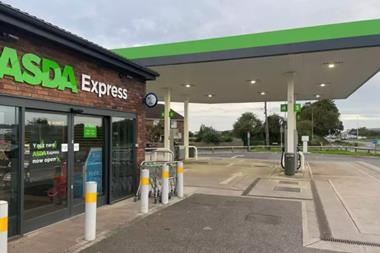It depends who the seller is, states Steve Rodell, director and head of retail at Christie & Co, when asked if it’s a buyer’s or seller’s market. "For example, if you’re an oil company and have a structured disposal programme that is linked to supply deals, it’s a seller’s market as so many dealers want an oil company disposal." David Collins, a director at Adlers, is more emphatic: "It’s definitely a seller’s market. There are so few opportunities available to smaller operators and there is a great deal of pent-up demand."
Both also agree that 2014 was a busy year for the forecourt property market. There was the eventual sale of Murco to MFG. Then Esso and Shell’s announcements about block disposals of sites into the dealer market, as well as BP’s expansion with M&S Simply food.
"We are in an exciting time of change," says Rodell, "where the ownership is shifting in favour of the dealer network. Some large tranches are being transacted and this will ultimately result in estate churn and single-site deals."
Collins says demand for convenience store-led sites, from both oil company/retailer alliances and major grocers looking to acquire standalone sites, has increased over the past 12 months.
Rodell adds: "I think we will see ongoing market entry from traditional c-store retailers who can bring a retail perspective to sites."
Mark Frostick, associate in the automotive and roadside team at Rapleys, says the market’s been the best it’s been for a good few years. He expects values to go up not just yet because of lack of stock on the market but he believes it will happen. "There’s definitely money out there. We’re getting to the point where we have four or five bids for a site whereas a couple of years ago we’d be happy if we got one."
"We are in a fairly bullish market at present and some buyers will incorporate the potential for improved trade into their bids," says Tom Rigg, principal surveyor, automotive and roadside at GVA. "This is a higher risk approach because the returns are merely forecasts, and buyers need to be realistic and confident in their numbers, and that they are sustainable; not just for the sake of their business, but also to persuade the bank that they can deliver the improved performance."
However, there are always sites that will command a premium. Rigg says GVA has just agreed a confidential going concern sale of a forecourt with just four pumps and a 700sq ft shop for a price in the order of £3m. "Needless to say, the site performs very well!" he says.
Frostrick adds: "If someone asks me, ’If I sell today will I get a sensible price?’, I’ll say there won’t be hundreds of parties interested but if yours is a top-of-the-market site then the supermarkets might be interested. And if yours is more at the bottom end and sensibly priced, you might get a buyer. But sensible is key."
Perhaps the biggest story in grocery retailing last year was the ’big four’ being thrashed by the discounters, which continued to gain market share.
Adam Wadlow, director at Barber Wadlow, says: "An interesting development in 2014 was the well-reported slowdown of the roll out of ’big box’ supermarket stores which often incorporate forecourts. Experian Catalist recorded 36 supermarket forecourts developed in 2014, by comparison to 46 in the previous year."
Frostick points to multi-national investment bank Goldman Sachs which has put forward the view that there might be a 20% reduction in retail capacity. "While the amount of stores that will actually be downsized is hotly debated, if the figures from Goldman Sachs are correct, conversely a reduction in retail space could see a boost to the petrol station market in the UK.
"Based on figures from the 2014 Fuel Market Review produced by Forecourt Trader and Experian Catalist, 20% of the existing hypermarket-run petrol stations would equate to 271 sites, supplying an average of just over 11 million litres of fuel. Assuming that all these forecourts closed, this fuel volume would have to go somewhere else and would provide the equivalent of approximately 1,500 new independent petrol stations or an additional half million litres per site for every existing independent.
"While this is purely a mathematical example, and we wouldn’t expect closures to be anywhere near these numbers, we could still expect there to be some closures and, given the performance of a supermarket petrol station, this could massively effect the surrounding market.
"Take, for example, a town with three independent petrol stations and two supermarkets one of which has a fuel station attached. If the supermarket with the fuel station were to close, not only would that additional fuel be available for the three independent sites, but they would also no longer have to compete on price with the often nationally set prices of the supermarket, so there would also be potential to improve margins."
But Frostick warns that we should not get carried away as the supermarkets love affair with the petrol station is far from over. "With the growth of Click and Collect the major brands are likely to be on the acquisition trail for busy locations with vacant excess space, and we could see Click and Collect replacing a number of hand car washes.
"If you’ve got the right site on a busy A-road there may be interest and you could get a big name on your forecourt which would be a big draw."
And despite a slowdown in big store openings, Wadlow reports that Asda remains acquisitive as the company seeks entry into the standalone petrol filling station sector. "At present, Asda has the smallest forecourt network out of the ’big four’ supermarkets. And Sainsbury’s continues to take leases on petrol stations as the company expands its c-store network on forecourts."
Wadlow says a reduced threat of competition will help protect forecourt property values but adds that a slowdown in supermarket forecourt growth, together with improved economic conditions, is likely to lead to more ’new to industry’ sites coming on line.
"But we do not expect a massive explosion of new sites with development costs at £2m-plus (including land purchase), the business case needs to be very compelling. Indeed, Barber Wadlow sells a lot more PFSs for under (as opposed to over) £2m!"
Frostick recommends that owners go through an agent for the advice and experience they can share.
"We look at all the options. We would say your site is worth x as a forecourt, or you could redevelop or even knockdown and rebuild. Or perhaps lose the forecourt element altogether and have a standalone convenience store there are many options." He says the fast food and beverage operators are always looking for new sites the likes of McDonald’s KFC and Starbucks.
Meanwhile, Wadlow points to BP/M&S’s acquisition programme, which continues securing leasehold and freehold deals, as well as swap deals, with a range of independent retailers nationwide. Plus Petrogas aka Applegreen continues to grow its UK network.
The firm has recently added to its growing forecourt presence in the UK with the successful letting of a petrol station in Hoddesdon, Hertfordshire, on a 19-year lease. This new property is Petrogas’ 50th site in England following the company’s initial expansion into the market from Ireland in 2008. The previous tenant, Shell, decided not to renew its lease and site owner, autocentre firm Mr Unique, appointed Rapleys to find a new occupier.
Frostick says: "This shows that traditional petrol stations are still desirable businesses and the market remains buoyant. When a big player like Shell decides to pull away from a site it is important, both to the site owner and the local community, that a new, stable, operator is put in place. Petrogas has a long-term plan to redevelop the site and, with their track record of successes, we think the future for this site looks bright."
Finally, Collins says Adlers found that the market continued to improve across 2014 and he expects that to continue this year.
"Funding does not appear to be an obstacle but the lack of stock on the market available to individuals and smaller operators has been significant."
As ever, many of the deals have been carried out on an off-market basis without the property being offered on the open market. Providing potential buyers with a degree of exclusivity is a good marketing ploy, particularly where experienced agents can identify likely purchasers rather than exposing the property to the open market and risking breaches of confidentiality and enquiries from weaker parties.
"With strong demand and a limited supply of openly marketed sites, sale prices remain strong and look set to grow for the foreseeable future."
CASE STUDY
Christie & Co helped the Cheema family purchase Tile Hill Service Station:
Steve Rodell, director and head of retail at Christie & Co, says: "We knew the Cheema family through their dealings with our Birmingham Office regarding the convenience market.
"After meeting initially through the ACS, we were instructed to find them a petrol station. The Cheemas had been eyeing Tile Hill and we were able to approach the owner through our extensive relationships in the dealer sector. This enabled us to facilitate the deal off market.
"Since acquisition, the Cheemas have applied their retail knowledge and expertise primarily to the shop. Rebranding, retraining staff, light refurbishment and reorganisation have paid almost immediate dividends and the shop is trading at double what it used to. This, of course, has enhanced the value of the site and indeed resulted in their Forecourt Trader of the Year Award. As a result, we remain instructed by them to find more sites in the Coventry/Warwickshire area."
Buying or Selling?
Sellers 2015 may see improved accounts presented due to increased margins. Prices are likely to improve so if you have been holding off making a decision to sell (or indeed refinance and invest in your site), seek an opinion of value from an agent close to the market.
Buyers don’t be afraid to ’make an offer’. Freehold advertised properties can sometimes be leased. Ask the agent.
Sellers one of the most important factors when selling is to have detailed and unambiguous trading records available. This will give a buyer confidence otherwise any anomalies in the records will create uncertainty in the mind of the buyer. Good records and a well-presented site can have a significant impact on the value of the filling station.
Sellers equally important is to have an environmental report available, preferably an intrusive Phase II survey, confirming that the ground conditions are suitable for continued use of the site as a petrol filling station.
Source: Adlers/Christie & Co
Forecourt property values
The headline news from Barber Wadlow’s Forecourt Property Value Indices (in association with Experian Catalist) is the 6% increase in petrol station property values in 2014, despite a 265% increase in supply. The value increase since the bottom of the market in 2011 therefore equates to 30%.*
The market experienced a 265% increase in sites sold/marketed in 2014 (circa 875 sites) by comparison to 2013 (circa 240 sites). Approximately 10% of the UK petrol filling station network has therefore been sold/marketed in 2014.
The most substantial transaction was MFG’s acquisition of the Murco network (228 sites), making it the second largest independent retailer in the UK. MFG was advised by Barber Wadlow.
The top five independent retailers now account for circa 13% of the UK petrol filling station network (1,100 sites) an increase from a circa 9.5% outlet share (800 sites) in 2013.
The major independent retailers are expected to grow further in 2015 as Esso and Shell conclude their divestment programmes.
Independent retailers of all sizes continue to take on new sites, as well as enhance the value of existing assets by redeveloping facilities to unlock trading potential.
*Value of the average ’bottom quarter’ of oil company sites (in terms of trading performance), which is now the most representative trading profile of the sites that are coming to the market.
No two forecourts’ trading performance is the same, making it virtually impossible to compare one transaction with another.
Barber Wadlow, working with Experian Catalist, has devised an Indices based upon opinions of value since 2000. To overcome a number of sector valuation issues, Barber Wadlow has based value on a freehold site that is unencumbered, free from contamination and fully operational, with no investment required. This research should be considered as an approximate guide only to market conditions.






























No comments yet